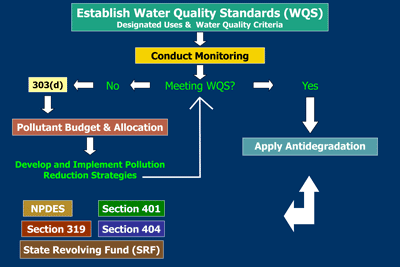CWA: Water Quality Based Approach—The Big Picture
The figure to the left (which is what this module refers to as the CWA Big Picture) provides further details on what will be discussed in this module. This figure is displayed several times in the module and allows students to jump to different sections of the module by clicking on the boxes in the figure. In addition, a link to the CWA Big Picture is provided under the Back and Next module navigators starting on the next slide on each text frame so that students can return to this navigation aid whenever necessary.
This module goes through the major CWA programs in the following sequence: (1) water quality standards; (2) antidegradation policy; (3) water body monitoring and assessment; (4) reports on condition of the nation’s waters; (5) total maximum daily loads (TMDLs); 6) NPDES permit program for discharges from point sources; (7) section 319 program for nonpoint sources; (8) section 404 program regulating discharge of dredged or fill materials to wetlands and other waters; and (9) section 401 state water quality certification; state revolving loan fund (SRF).
Throughout the module, some highlighted terms can be found in the glossary which pops up when you click on the term. This module could take several hours to complete. Students can vary the depth of the course by choosing to focus on certain subsections of this module. Also, throughout the module, links to other websites are provided that cover particular programs or topics in detail. These are strictly optional and are not essential to understanding the basics of the CWA. Exploring these additional informational resources can easily double or triple the amount of time it takes to navigate this module.
Brief Overview of Key CWA Elements
First, water quality standards (WQS) consistent with the statutory goals of the CWA must be established. All waters must have designations for how they’re used, and numeric and/or narrative criteria that support those uses. Antidegradation policies and implementation methods are also required, to ensure that high quality are not unnecessarily degraded and that all waters meet their minimum water quality criteria. Then water bodies are monitored to determine whether the WQS are met.
If all WQS are met, antidegradation policies and implementation methods are employed to keep the water quality at acceptable levels. Ambient monitoring [Link to glossary] is also needed to ensure that this is the case.
If the water body is not meeting WQS, a strategy for meeting these standards is needed. Key elements of a strategy include: (1) a Total Maximum Daily Load (TMDL); and (2) a TMDL implementation plan. TMDLs determine what level of pollutant load would be consistent with meeting WQS. TMDLs also allocate acceptable loads among sources of the relevant pollutants.
Necessary reductions in pollutant loading are achieved by implementing strategies authorized by the CWA, along with any other tools available from federal, state, and local governments and nongovernmental organizations. Key CWA tools include the following:
- NPDES permit program: Covers point sources of pollutants discharging into a surface water body.
- Section 319: Addresses nonpoint sources of pollution, such as most farming and forestry operations, largely through education and cost-share grants.
- Section 404: Regulates the discharge of dredged or fill materials into wetlands and other Waters of the United States.
- Section 401: Requires federal agencies to obtain certification from the state, territory, or Indian tribes before issuing permits that could result in increased pollutant loads to a water body. The certification is issued only if such increased loads would not cause or contribute to exceedances of water quality standards.
- State Revolving Funds (SRF): Provides large amounts of money through loans for municipal point sources, nonpoint sources, and other activities.
After implementing these strategies, water body conditions are again measured and compared to ambient water quality standards. If standards are now met, only occasional monitoring is needed. If standards are still not being met, then a revised strategy is developed and implemented, followed by more ambient monitoring. This iterative process must be repeated until standards are met.

![[logo] US EPA](https://www.epa.gov/epafiles/images/logo_epaseal.gif)